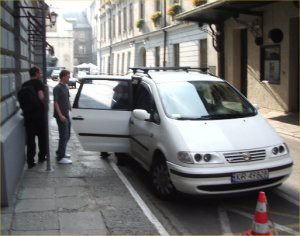 |
Due to slightly poor planning (and also the abandon, that comes with having a great time) we realized that it was our last day, and we hadn’t seen the Wieliczka Salt mine, nor visited Auschwitz.Accustomed now to style, having spent 3 nights in the most prestigious hotel in the city, we decide a private car and driver, is the only way to go.Here, the lads take part in that most manly of pursuits, who will sit in the front.For the record, and without bragging, it was me. |
| As we arrive at the Salt Mine, our private guide leads us down the wooden stairs to the mine.Like many of the Poles I met in Krakow, here English was so good, it embarrassed me. |
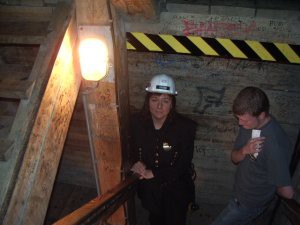 |
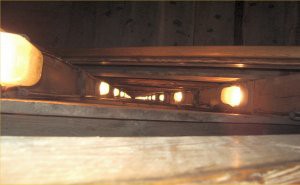 |
A view down through the centre of the staircase, shows the sheer number of flights of stairs, that needed to be descended.A trip to a Salt mine, might not sound like much of a day out, but its reputation is outstanding.Originally started in the 13th Century, there are records of Salt being used from this site, 3500, BC.
It is a UNESCO world heritage site, and was once considered the 8th man made wonder of the world. |
| As we reach the bottom of the stairs, our guide shows us one of the walls made from salt.It was quite claustrophobic in the mine, but a surprising thing was how fresh and cool the air was.There were several different groups, and our guide cleverly steered us around them, so we always got plenty of time to look at the exciting things in the mine. |
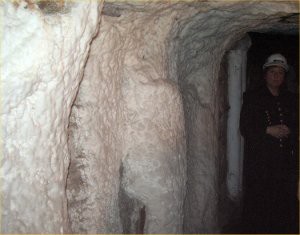 |
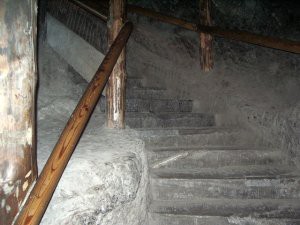 |
As we descend further, these “steps” were cut from rock salt.The salt in the mine, isn’t the stuff you can put straight on your fish and chips, it has to be treated once its been dug out of a mine. |
| One of the walkways, further into the mine.It captures the depth and “closed in” feel of the mine. |
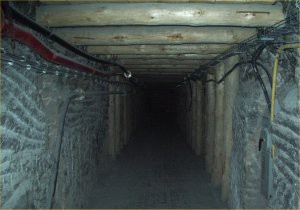 |
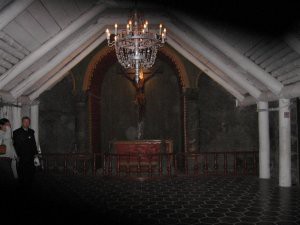 |
The miners, were traditionally very religious people. While taking lunch, it simply wasn’t practical to go back to the surface.Hard working people that they were, they decided to “carve” things such as this small chapel out of the rock salt.If you look at the floor, this are not tiles placed on the floor, but actually carved into the rock salt.The crucifix and the archway are also carved from rock salt. |
| A Sign showing the depth at one point of the mine.Nearly 500 feet, half the height of Ayres Rock. |
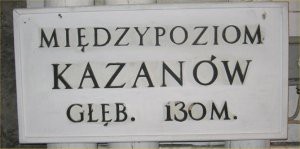 |
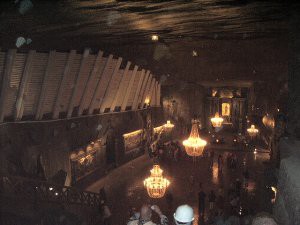 |
The internationally famous Chapel of the Blessed Kinga.To all intents and purposes a full blown church, the only difference being that it is 200 meters underground. |
| Carved entirely from salt, (including the chandeliers that hang from the ceiling) not by an outsider, but by gifted miners themselves.Here, one of the walls showing many of the carved mosaics. |
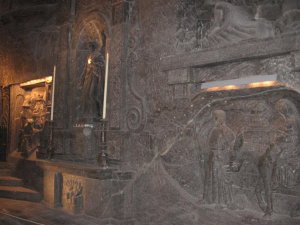 |
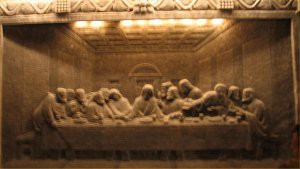 |
The last supper, probably the finest piece carved into the wall, about 5 feet across.Its 3 dimensional look, comes from the fact that it is actually carved 12 inches into the back of the wall, to give it depth. |
| Not very easy to see (the white salt, could react badly to the flash from my camera, and I was lucky that most of my pictures, turned out okay).The quotes of Johann Wolfgang von Goethe (1749 -1832) have always been an inspiration to me.Imagine my surprise, to find a statue to him here in the mine !. Turns out, that amongst his talents, he was also a mining engineer, and had worked extensively at Wieliczka.My favourite quote of his:”The moment one definitely commits oneself, then providence moves too.””All sorts of things occur to help one that would never otherwise have occurred.””A whole stream of events issues from the decision, raising in one’s favour all manner of unforeseen incidents and meetings and material assistance which no man could have dreamed would have come his way.” |
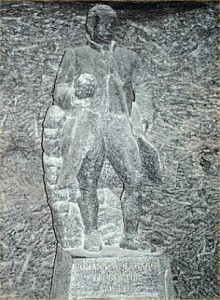 |
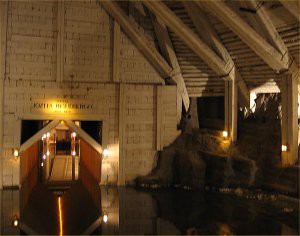 |
The underground Salt Lake.Our guide explained that some drunken people had been in a boat which had turned over, and because of the content of Salt in the water, they floated, and some of them suffocated, trapped under the upturned boat unable to submerge.I asked when it would re-open. She said that the incident had happened in 1918, so didn’t think it was likely to open soon !. |
| Before we headed back to the surface (there was a lift to take us back up, so no Alpine trekking to the top, for us).A formal assembly hall. Our guild explained that Presidents and Kings have been entertained here.Banquets and state occasions are hosted here, fairly regularly Robert Baden Powell (the founder of the scouting movement) and Pope John Paul II were the ones I found interesting. |
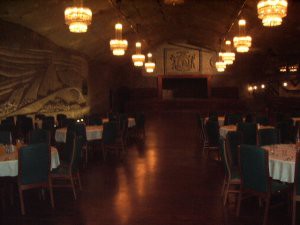 |
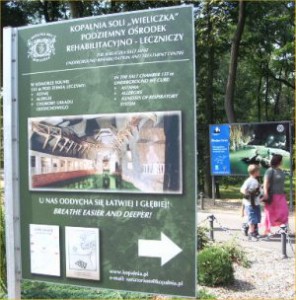 |
As we wondered back to our car and driver, I noticed this advertisement, for a clinic based in the mine.Apparently, people with chest complaints, can spend time relaxing in the mine, and the dry cool air will help to cure them.An amazing commercial and humanitarian use for a truly amazing place. |
| The cynical inscription Arbiet macht frie (work makes you free) over the gate.This was Auschwitz 1, converted from an army barracks to a concentration camp, in 1940 on the orders of Henrick Himmler.Most people think of auschwitz as one place, but Auschwitz 2, is based at Birkenau nearby. |
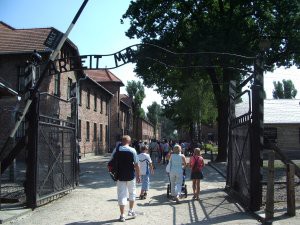 |
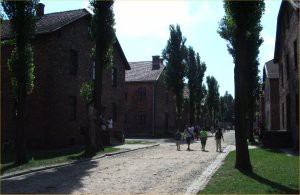 |
I had previously visited the Killing Fields in Phnom Pen, but it was nothing like this.You could almost feel the repression, fear and hopelessness.1.5 million people died here, at the hands of fellow human beings.As I saw more of the camp, I came to wonder if that was an appropriate description. |
| People were chosen to be sent straight to the gas chamber, or to literally be worked to death.Everything about the place was about breaking the spirit of the inmates. Public hangings during role call, were fairly common.During the freezing winter, dousing in cold water, as a means of execution, was commonplace.It must take a very low regard for other human beings, to do these kind of things. |
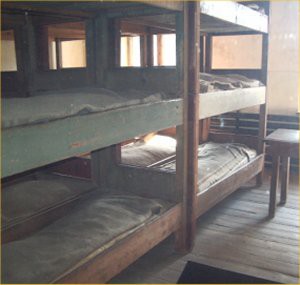 |
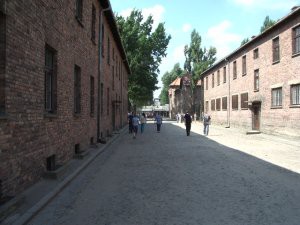 |
If a Polish prisoner escaped, his family would immediately be sent to Auschwitz.They would be made to wear a sign explaining why they were there, so the penalty for escaping, became well known.Auschwitz isn’t small, but if you look at the facing walls on these buildings, you can get something of the feeling of claustrophobia that descends on this place. |
| The Nazis shot thousands of people against this wall.Normally political prisoners, clandestine operatives and people who helped others to escape.A sign leading here, said “you are entering a courtyard where the SS murdered thousands of people. Please maintain silence: remember their suffering and show respect for their memory”.I saw one bunch of flowers being placed here by some young people, who’s great grandfather had died against this wall. |
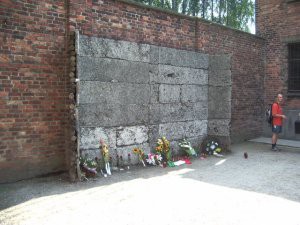 |
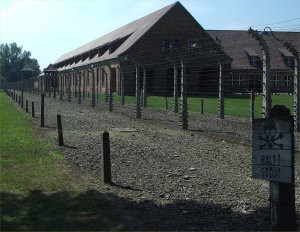 |
It was in Auschwitz 1, that Maksymilian Kolbe a Franciscan priest, gave up his life for another inmate.For his “crime” Kolbe (who was later canonized), was sentenced to death by starvation. |
| The camp “orchestra” used to play here.I couldn’t imagine what kind of sick mind, would torment people already facing death, by playing them music.The Nazis were nothing if not practical. The music was designed to make the prisoners move in time, so the line moved at a speed where they could be counted easily.The “musicians”, were literally playing for their lives. |
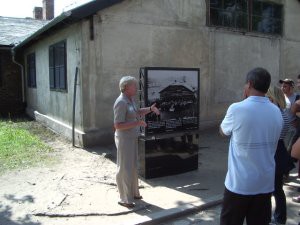 |
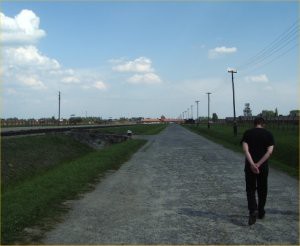 |
Our driver took us to Auschwitz 2, Birkenau, and advised us he would drop us of at the back of the site, to avoid crowds.This walkway, shows the sheer size of the place.As we walked towards the entrance, nobody felt like talking much. |
| At the end of the war, the Nazis ordered many of the buildings to be destroyed with dynamite .This is one of the demolished buildings.The silence was broken, when the mobile phone of a nearby person began ringing. He quickly silenced it. |
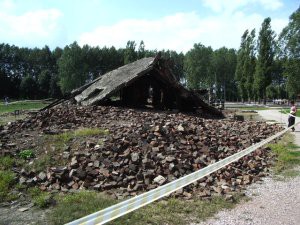 |
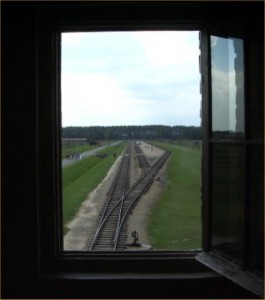 |
Through a window in the upstairs room of the gatehouse, its possible to see the full length of the railway lines leading to the disembarkation area.From here, people would be chosen for extermination, or literally worked to death.Another option, was for a person to be chosen for experimentation.Joseph Mengele, would make a point of being there, whenever the train arrived, to make the clinical selection himself, his preference was for identical twins.It was said, that once selected he treated twins like his own Children. |
| The railway sidings, where many people would leave the train, and be dead minutes later.Its not easy to describe the feeling, when standing at the end of these railway lines.Something akin to the end of hope. Until this point, the poor people on the train must have thought some kind of intervention or luck would save them.We were told a story where Mengele had selected a young girl for experimentation.Her mother put up a savage fight, and bit one of the guards who was trying to remove her daughter.Mengele drew his pistol (quite why a Dr was carrying a pistol, was never explained) and shot them both.He then ordered that day’s arrival (thousands of people) to be sent to the gas chambers in its entirety, before returning to his office for a cup of coffee. |
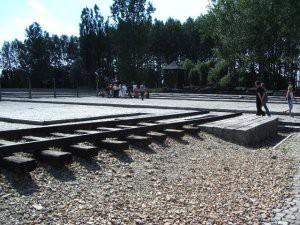 |
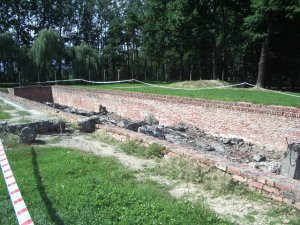 |
The remains of an actual gas chamber.Hundreds of thousands of people died here.Most of you know, that I am not religious, but I hope there is a special place in Hell for Joseph Mengele, and the others responsible for these crimes, which for me, are beyond words.If you want to visit a great holiday destination, then go to Krakow, you wont regret it.If you have problems in your life, visit Auschwitz.Your problems won’t go away, but they will certainly be put into perspective. |